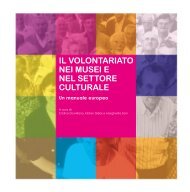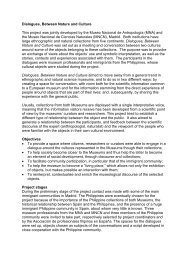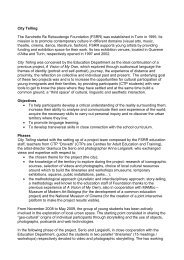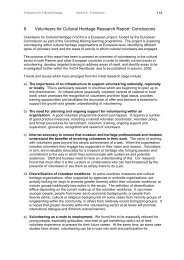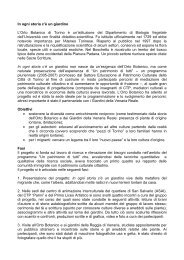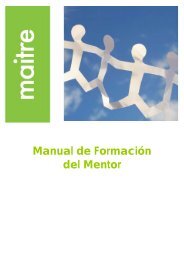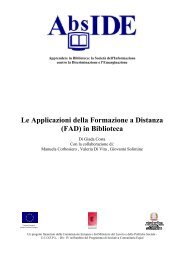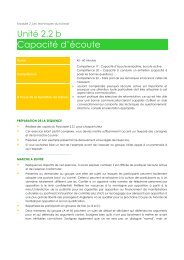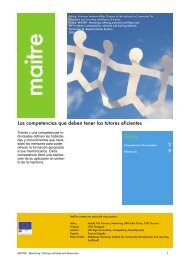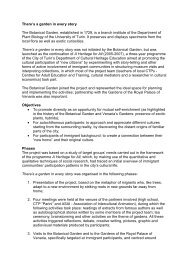Museums as places for intercultural dialogue - Network of European ...
Museums as places for intercultural dialogue - Network of European ...
Museums as places for intercultural dialogue - Network of European ...
You also want an ePaper? Increase the reach of your titles
YUMPU automatically turns print PDFs into web optimized ePapers that Google loves.
In the British context, however, the term “ethnic arts” is only appliedto what is created by those <strong>of</strong> non-<strong>European</strong> origin. The term alsosuggests that what they are creating is not “art,” to rate with the art<strong>of</strong> Europe, but “arts,” a humbler activity that deserves less seriousnotice, if indeed it deserves any notice at all. When the Arts Council,the Gulbenkian Foundation and the Community Relations Commissionsponsored a report entitled The Arts Britain Ignores, R<strong>as</strong>heed Araeencommented that it is not that Britain ignores these arts, but that itrefuses to accept them.Kwesi Owusu commented that in seeking a solution to what is defined<strong>as</strong> the problem <strong>of</strong> ethnic arts, the report dealt with the huge historicalquestion <strong>of</strong> cultural domination and appropriation by proposingcommunication. But “communication” is not enough: there must berecognition. And it must be recognition that these arts are innovativeand dynamic. They must not be marginalised ‘by relegating them top<strong>as</strong>t histories, <strong>as</strong> if they were some contemporary <strong>for</strong>m <strong>of</strong> “primitiveart”.’Bibliographic referencesS. Amin, Eurocentrism, Zed Books, London, 1989.R. Araeen, Making myself visible, Karia Press, London, 1984.M. Bernal, Black Athena: The Afro-Asiatic Roots <strong>of</strong> Cl<strong>as</strong>sical Civilization, vol. 1, FreeAssociation Books, London, 1987.E. Iverson, Canon and Proportion in Egyptian Art, Aris & Phillips, Warminster, 1975.N. Khan, The Arts Britain Ignores – The arts <strong>of</strong> ethnic minorities in Britain, Arts Council<strong>of</strong> Great Britain, 1976.C. McCarthy and O.W. Critchlow, Race Identity and Representation in Education,Routledge, London, 1993.K. Owusu, The Struggle <strong>for</strong> Black Arts in Britain, Comedia, London, 1986, p. 60.E. Said, “Orientalism Reconsidered”, in Race and Cl<strong>as</strong>s, vol. XXVII, 2, 1986, p. 2.E. Said, Culture and Imperialism, Vintage, London, 1993.R. Taylor, Educating <strong>for</strong> Art: Critical Responses and Development, Longman, London,1986, pp. 107-33.A. J. Toynbee, Civilization on Trial, Meridian, New York, 1958, p. 11.R. Williams, Culture and Society, 1780-1950, Chatto & Windus, London, 1958, p. 376.What we have to consider is how (to use Edward Said’s definition),‘the production <strong>of</strong> knowledge best serves communal <strong>as</strong> opposedto sectarian ends; how knowledge that is non-dominative and noncoercivecan be produced in a setting that is deeply inscribed with thepolitics, the considerations, the positions and the strategies <strong>of</strong> power.’The oppressed peoples <strong>of</strong> the world have continued to contributeto art. Modern art in Latin America, Asia and Africa is vibrant anddynamic. Their cultural systems are not frozen, nor do they have a fixedstatus. Educators and art historians need there<strong>for</strong>e to challenge themuteness imposed upon the artistic images <strong>of</strong> oppressed civilisations.Without working in a particularistic manner, specialist fields or discretedisciplines, educators should try to establish more progressive ways<strong>of</strong> interpreting other cultures and other arts. The first process theymay have to consider is to ‘unlearn,’ <strong>as</strong> Raymond Williams says, ‘theinherent dominative mode,’ avoiding the portrayal or the containment<strong>of</strong> those outside the dominative framework, be they blacks, womenor “Orientals,” and letting “the other” speak <strong>for</strong> itself. This is not,however, an issue <strong>of</strong> “political correctness” or <strong>of</strong> relativism <strong>of</strong> Englishspeaking “multicultural policies,” but <strong>of</strong> redressing substantive historicalexclusions within world art.Thus, by developing ‘an oppositional critical consciousness,’ arthistorians and curators can not only <strong>as</strong>sist in dismantling the mythicalnotions <strong>of</strong> the mysterious Orient, the uncivilised African, or the curiousAmerindian, but can also be <strong>as</strong>king fundamental questions aboutartistic endeavour at the human level <strong>as</strong> a whole, without being lockedinto the discourse <strong>of</strong> a single discipline. They can interrogate andchallenge what is normally taken <strong>for</strong> granted. And so, in learning fromthe artistic history <strong>of</strong> humanity <strong>as</strong> a holistic community, we may be ableto avoid the ‘seductive degradation <strong>of</strong> knowledge.’12 13



